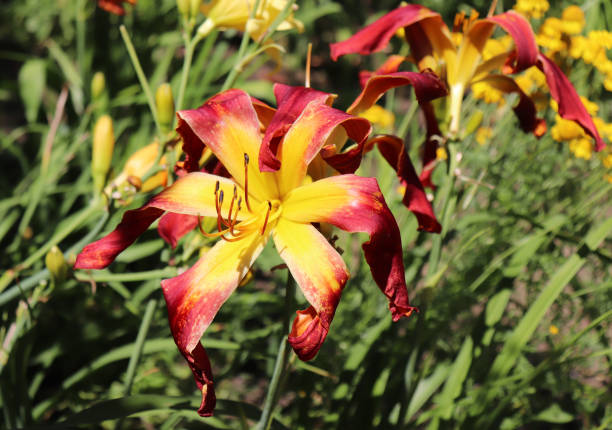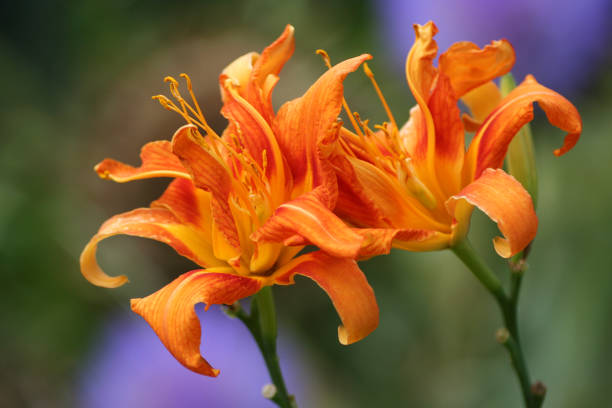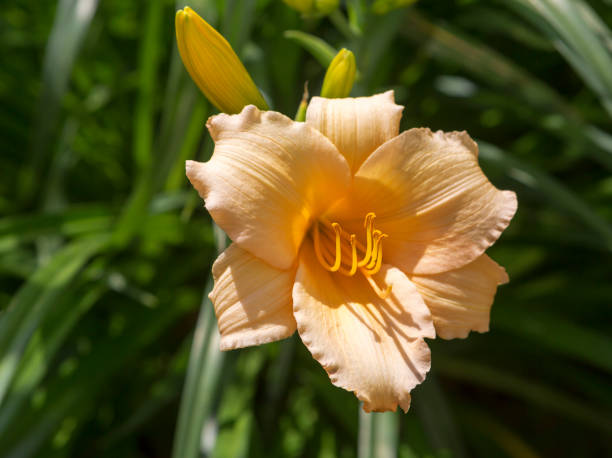Which Daylilies Are Edible? Facts You Need To Know
The safest edible daylily is the common daylily, Hemerocallis fulva. It is not only possible to eat but also visually appealing. The flowers, flower buds, young stalks, and root tubers were delicious and delectably sweet. However, there’s a concern about daylily toxicity and whether they are safe to eat or not. Make sure your plant is a daylily, as true lilies that look like daylilies can cause serious gastrointestinal problems and other symptoms. Continue reading!
Table of Contents
Confusion Between “Daylily” and “Lily”
Much of the misunderstanding about whether daylilies are safe to eat stems from the semantic legacy of the word “lily.” At times and in some parts of the world, the common names “daylily” and “lily” have been used interchangeably to refer to plants belonging to two very distinct plant families.
Consider the term “tiger lily.” I’m familiar with the term “tiger lily” is applied to two distinct plants: one is a daylily (family Xanthorrhoeaceae, subfamily Hemerocallidoideae), and the other is a lily (the family Liliaceae). While the first is widely accepted as safe to eat, the second is well-documented as toxic to all animal forms, including humans.
In 2009, the Scientific Classification of Daylilies was revised. Before 2009, daylilies were classified scientifically as Liliaceae. Numerous Liliaceae species, including the aforementioned toxic tiger lily (as well as the more commonly known Easter and Asian lilies), have long been toxic to animals, including humans. Thus some assumed that daylilies possessed the same toxic properties as lilies. They do not do so.
In 2009, the APG III system classified daylilies as part of the Xanthorrhoeaceae family, subfamily Hemerocallidoideae.

Issue Regarding Toxicology to Animals
The ASPCA states unequivocally that daylilies are toxic to cats and cows, despite the absence of scientific evidence, while simultaneously classifying Hemerocallis as a member of the Liliaceae family.
The House on Red Hill blog highlights this issue from the perspective of a cat owner and long-time daylily gardener who discovers for the first time, thanks to a poster in the vet’s office, that daylilies are toxic to cats.
Issue Regarding Toxicology to Humans
Dr. Peter A. Gail, a botanist who specializes in daylilies and other edible foraged foods, advises humans to exercise caution when consuming daylilies. Any newly introduced food may cause an allergic reaction, and any food consumed in excess may harm a particular individual. However, neither intolerance nor an allergic reaction to a particular food indicates that the food is poisonous.
MerriwetherForager, a Ph.D. research chemist and naturalist, recommends sticking to Hemerocallis fulva, the most well-known daylily species, and avoiding newer hybrids, some of which may be toxic.
Thus, while it is relatively simple to identify the original daylily and a daylily cultivar, determining whether the latter is edible is more difficult. That is why it is necessary to consult a local expert and the daylily’s owner. If someone claims their daylily is edible, request proof.

Edible Daylily Parts
Now we can move on to what parts we can eat. For centuries, the plant has been used in Asian cuisine, and it is even thought to have medicinal properties. Daylilies originated in Asia but have since become naturalized throughout most United States. They are, in fact, noxious weeds in many states. For serious foragers, wild daylilies are a rare sight.
You can harvest four edible parts of the daylily throughout the year. These are:
Flowers
They can be eaten either dry or fresh. There is a lot of color in salads when there are fresh leaves. The petals are pretty, but they don’t taste very good.
The one-day-only open flower can be wrapped around rice or other savory stuffing. Dry leaves can be added to pasta to make it look orange or yellow. The flowers taste like sweet iceberg lettuce when they’re just open. Whether making a salad or snacking on them in the garden, remove the pollen-covered parts first. You should pick the flowers when you’re ready to start cooking. Make sure they stay cool but not cold in a covered container if you have to pick them up before they are ready. Always pick blossoms that have just opened. You might need to pick one or two more than the eight called for because sometimes a petal breaks or tears. It’s best to make the herb ricotta filling up a day in advance. Then put it in the fridge.
Flower Buds
The flower buds are quite tasty. Their flavor is similar to young green beans when sautéed or steamed. Use them in the same way. Also, they can taste like a mix of green beans and asparagus.
Unopened buds can be harvested when they are an inch long and completely green, up to three inches long, and showing color. Now we’re getting into the nitty-gritty. You can eat them raw in salads because they have the crunch and flavor of green beans. They also make fantastic pickles. Daylily buds are delicious, lightly sautéed in olive oil with salt and pepper. Daylily buds are used in classic hot and sour soup in Chinese cuisine.
Young Shoots
In the spring, they can be eaten fresh or gently sautéed. They are similar to young asparagus shoots but have a milder flavor. You can only pick young shoots until they’re about five inches long. After that, they’re too hard to work with. Do not be afraid. They will grow back. People like them because they’re mild and crunchy, and they’re a good side dish.
Tubers
The tubers are the best parts. They are used in the same way as fingerling potatoes but have a stronger flavor. The thickened roots can be eaten like Jerusalem artichokes (sunchokes) from late fall until early spring, but not in the summer.
The majority of edible lily bulbs available in markets are imported from mainland China. Many Asian cultures use the lily bulb, particularly Lilium lancifolium, in traditional cuisine. As a result, the recipes are frequently Oriental. Cooked Lily bulbs have a flavor similar to turnips, are crunchy, sweet, and starchy in texture. According to some, the taste of the bulb takes on a mild chestnut flavor with a slightly bitter aftertaste. They are frequently used in stir-fries, soups, stews, and even baked. They taste like waxy (red bliss) potatoes rather than fluffy (russet) potatoes.
Daylilies are an excellent wild edible for beginning foragers because they are plentiful, tasty, and easy to identify. This is truly a plant that nourishes both the body and the soul.
Daylily tubers are plump and full of stored starches in the fall or early spring. Remove about half of the tubers from a clump. Make sure to replant anything you aren’t going to cook with. Remove the root hairs from the tubers and thoroughly clean them. There’s no need to peel them before eating, but you’ll probably need to wash them several times. Coat them in olive oil, salt, and pepper before roasting them at 450°F. Daylily tubers also make a deliciously crisp pickle. Pour your brine over the tubers and cook for 10 minutes in a boiling water bath.

Preparation of Daylily Edible Parts
Eat Daylily Shoots
Serve them uncooked if possible. During the first few weeks of spring, you can take advantage of the plant’s tender new growth. Cut them back to the ground when they reach a height of 8 inches (20 cm). They will become fibrous and tough if they grow any taller than this. Remove the tough outer leaves and savor the juicy, flavorful core. Raw daylily shoots are delicious, but you can also add flavor to them by dipping them in a veggie dip like ranch.
Daylily shoots can be cut back without affecting the plant’s growth ability. New shoots will continue to grow from the roots as long as the plant is healthy.
Infuse Your Salad With Daylily Shoots
This will disguise their aftertaste. Mix the daylily shoots with various vegetables, including mixed greens, tomato, cucumber, and celery. Daylily, Sprouts can be added to the salad and topped with your favorite dressing, such as oil and vinegar or balsamic vinegared dressing.
Stir-Fry Daylily Shoots for Extra Flavor
With the addition of other vegetables, daylily shoots are a delectable dish. You might want to try cooking with daylily shoots next time. Toss the daylilies with tamari, garlic, and olive oil. Then, add other vegetables like broccoli, squash, peppers, and onions, and serve them over rice or noodles as a final touch.
Adding chicken, beef, or shrimp as a protein source is another option.
Cooking with Daylily Tubers
Remove the roots and rhizomes. Tubers are small, pea-sized roots that resemble fingerling potatoes. Before cooking the tubers, separate them from the rest of the daylily plant’s roots and rhizomes. This can be accomplished by cutting the tubers from the root.
Clean the tubes. You should wash and scrub your tubers in warm water after taking them out of the root. To clean the tuber, do this. It will eliminate any soil and dirt that is still on it. It’s optional to peel the tubers before cooking them.
Bring the tubers to a boil, then drain and serve. Using medium-high heat, cook the tubers in a medium pot. For 15 minutes or until the potatoes are fork-tender, bring a pot of water to a rolling boil. Toss the tubers in butter and season to taste with salt and pepper after being cooked to your preference.
Fry the potatoes in butter until they are tender. The tubers can also be fried in butter. On the stove, heat a frying pan to medium-high heat. Cooking time is estimated to be between 10 and 15 minutes. Throw in some chopped onion and minced garlic to add more flavor.
Tasty Flower and Buds
During the summer, daylily buds and flowers can be harvested. Daylilies will bloom during the summer months. The flowers will only be in bloom for one day, thus the name. The plant will continue to flower, with new buds appearing daily. Pick the buds a day before blooming for the best results. This time of day is ideal for picking flowers because they are most beautiful when they bloom.
Fry daylily buds in a skillet. Daylily buds can be eaten by frying them in a pan with a little butter, garlic, and salt until crispy. Using this straightforward recipe gives you a sense of the flavor without overwhelming them with excessive seasonings and other ingredients.
Asparagus and green peas are the flavors that come to mind when thinking of daylily buds.
Fried daylilies are a delicious side dish to serve with a meal.
Deep fry. A simple batter is all that is needed to try deep-frying daylily buds. You dip the buds into the simple batter, deep-fry them and then sprinkle them with salt. People at your next backyard barbecue will be impressed by this tasty summer treat. Do this, and you’ll have a dish that everyone will love.
Ingredients:
- 1 cup of flour
- 1 tablespoon of baking powder
- 1/2 teaspoon salt should be mixed to make a simple batter. You should also add some water.
Direction:
- Dip the buds into the batter, then fry them in oil for about a minute or until they are crispy.
Consume the flowers raw. Daylily flowers have a sweet flavor and can be eaten raw. When selecting a daylily flower, include the bulb near the flower’s base.
Raw daylily flowers can add color and summer freshness to your favorite salad recipe!
Other Applications
Who knew Lilies could be used for so many other things? It’s also worth noting that they’re quite medicinal. Native American cultures have traditionally used them to treat coughs, sore throats, and expectorants. They are also well-known for their cardiovascular benefits.
